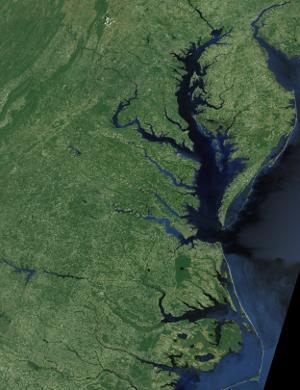

The Chesapeake Bay area, with Baltimore to the north is shown. Image courtesy NASA Goddard Space Flight Center Landsat Data Continuity Mission Education and Public Outreach team (GSFC LDCM EPO).
Credit
NASA Goddard Space Flight Center Landsat Data Continuity Mission Education and Public Outreach team (GSFC LDCM EPO).
The intensity, duration, and frequency of extreme temperature- and precipitation-based events are key components to understanding the climate of Chesapeake Bay.
Kari Pohl of the Center for Environmental Science at the University of Maryland and colleagues studied these components by calculating 26 extreme climate indices defined by the Expert Team on Climate Change Detection and Indices. She will report their findings at the Annual Meeting of the Geological Society of America on 1 November in Baltimore, Maryland, USA.
“A traditional view of historic climate change is to determine mean annual changes,” Pohl explained. “However, organisms do not feel means; they feel the day-to-day variability and extreme events, such as the frequency of warmer-than-normal days.”
The goals of the project include reconstructing extreme climate changes from the recent past (1894-2014), using historically referenced data to assess near-future global climate model projections, and to ultimately use this analysis to investigate ecological problems in Chesapeake Bay, such as eelgrass diebacks.
The study saw changes that included an overall decrease in cold events, a higher probability to have a year without a cold spell, and an increase in the annual number of wet days.
These extreme climate indices were strongly correlated to the shallow water environment, including streamflow and water temperature. These linkages will allow insights on how extreme changes could affect environmental boundaries and critical threshold events of vulnerable organisms.
Pohl hopes that studies such as this one “will enhance our general understanding of historical and future extreme climate variability, allowing policy-makers to make better-informed decisions for coastal communities.”
###
CONTACT:
Kari Pohl, Center for Environmental Science, University of Maryland
kstlaurent@umces.edu
WHAT:
Session No. 54: Restoring the Nation's Largest Estuary: Lessons Learned from Efforts to Address Changes in Water Quality and Ecosystem Structure and Function within the Context of Landscape Change and Climate Variability in the Chesapeake Bay and Its Watershed
Session hyperlink: https:/
Paper No. 10: Chesapeake Bay Climate Extremes and Variability: a Recent Past, Present, and Near Future Analysis
Abstract hyperlink: https:/
WHEN & WHERE:
Sunday, 1 November 2015: 1:30-5:30 PM
Room 308 (Baltimore Convention Center)
Presentation Time: 3:55 PM
The Geological Society of America, founded in 1888, serves more than 27,000 members from academia, government, and industry in more than 100 countries. Through its meetings, publications, and programs, GSA enhances the professional growth of its members and promotes the geosciences in the service of humankind. GSA encourages cooperative research among earth, life, planetary, and social scientists, fosters public dialogue on geoscience issues, and supports all levels of earth science education.












